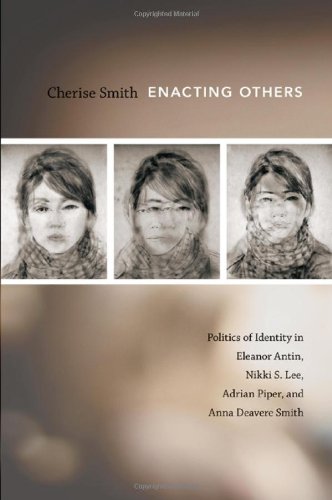Passing for White, Passing for Black
Transition
Number 58 (1992)
pages 4-32
Adrian Piper
It was the New Graduate Student Reception for my class, the first social event of my first semester in the best graduate department in my field in the country. I was full of myself, as we all were, full of pride at having made the final cut, full of arrogance at our newly recorded membership among the privileged few, the intellectual elite, this country’s real aristocracy, my parents told me; full of confidence in our intellectual ability to prevail, to fashion original and powerful views about some topic we represented to ourselves only vaguely. I was a bit late, and noticed that many turned to look at – no, scrutinize me as I entered the room. I congratulated myself on having selected for wear my black velvet, bell-bottomed pants suit (yes, it was that long ago) with the cream silk blouse and crimson vest. One of the secretaries who’d earlier helped me find an apartment came forward to greet me and proceeded to introduce me to various members of the faculty, eminent and honorable faculty, with names I knew from books I’d studied intensely and heard discussed with awe and reverence by my undergraduate teachers. To be in the presence of these men and attach faces to names was delirium enough. But actually to enter into casual social conversation with them took every bit of poise I had. As often happens in such situations, I went on automatic pilot. I don’t remember what I said; I suppose I managed not to make a fool of myself. The most famous and highly respected member of the faculty observed me for awhile from a distance and then came forward. Without introduction or preamble he said to me with a triumphant smirk, “Miss Piper, you’re about as black as I am.”
One of the benefits of automatic pilot in social situations is that insults take longer to make themselves felt. The meaning of the words simply don’t register right away, particularly if the person who utters them is smiling. You reflexively respond to the social context and the smile rather than to the words. And so I automatically returned the smile and said something like, “Really? I hadn’t known that about you.” – something that sounded both innocent and impertinent, even though that was not what I felt. What I felt was numb, and then shocked and terrified, disoriented, as though I’d been awakened from a sweet dream of unconditional support and approval and plunged into a nightmare of jeering contempt. Later those feelings turned into wrenching grief and anger that one of my intellectual heroes had sullied himself in my presence and destroyed my illusion that these privileged surroundings were benevolent and safe; then guilt and remorse at having provided him the occasion for doing so.
Finally, there was the groundless shame of the inadvertent impostor, exposed to public ridicule or accusation. For this kind of shame, you don’t actually need to have done anything wrong. All you need to do is care about others’ image of you, and fail in your actions to reinforce their positive image of themselves. Their ridicule and accusations then function to both disown and degrade you from their status, to mark you not as having done wrong but as being wrong. This turns you into something bogus relative to their criterion of worth, and false relative to their criterion of authenticity. Once exposed as a fraud of this kind, you can never regain your legitimacy. For the violated criterion of legitimacy implicitly presumes an absolute incompatibility between the person you appeared to be and the person you are now revealed to be; and no fraud has the authority to convince her accusers that they merely imagine an incompatibility where there is none in fact. The devaluation of status consequent on such exposure is, then, absolute; and the suspicion of fraudulence spreads to all areas of interaction.
Mr. S. looked sternly at Mrs. P., and with an imperious air said, “You a colored woman? You’re no negro. Where did you come from? If you’re a negro, where are your free papers to show it?” … As he went away he looked at Mr. Hill and said, ‘”She’s no negro.”
The Rev. H. Mattison, Louisa Picquet, The Octoroon Slave and Concubine: A Tale of Southern Slave Life (1861), 43.
The accusation was one I had heard before, but more typically from other blacks. My family was one of the very last middle-class, light-skinned black families left in our Harlem neighborhood after most had fled to the suburbs; visibly black working-class kids my age yanked my braids and called me “Paleface.” Many of them thought I was white, and treated me accordingly. As an undergraduate in the late 1960s and early 1970s, I attended an urban university to which I walked daily through a primarily black working-class neighborhood. Once a black teenaged youth called to me, “Hey, white girl! Give me a quarter!” I was feeling strong that day, so I retorted, “I’m not white and I don’t have a quarter!” He answered skeptically, “You sure look white! You sure act white!” And I have sometimes met blacks socially who, as a condition of social acceptance of me, require me to prove my blackness by passing the Suffering Test: They recount at length their recent experiences of racism and then wait expectantly, skeptically, for me to match theirs with mine. Mistaking these situations for a different one in which an exchange of shared experiences is part of the bonding process, I instinctively used to comply. But I stopped when I realized that I was in fact being put through a third degree. I would share some equally nightmarish experience along similar lines, and would then have it explained to me why that wasn’t really so bad, why it wasn’t the same thing at all, or why I was stupid for allowing it to happen to me. So the aim of these conversations clearly was not mutual support or commiseration. That came only after I managed to prove myself by passing the suffering Test of blackness (if I did), usually by shouting down or destroying their objections with logic…
…Trying to forgive and understand those of my relatives who have chosen to pass for white has been one of the most difficult ethical challenges of my life, and I don’t consider myself to have made very much progress. At the most superficial level, this decision can be understood in terms of a cost-benefit analysis: Obviously, they believe they will be happier in the white community than in the black one, all things considered. For me to make sense of this requires that I understand—or at least accept—their conception of happiness, as involving higher social status, entrenchment within the white community and corresponding isolation from the black one, and greater access to the rights, liberties and privileges the white community takes for granted. What is harder for me to grasp is how they could want these things enough to sacrifice the history, wisdom, connectedness and moral solidarity with their family and community they must sacrifice in order to get them. It seems to require so much severing and forgetting, so much disowning and distancing, not simply from one’s shared past, but from one’s former self—as though one had cauterized one’s long-term memory at the moment of entry into the white community….
Read the entire article here.



